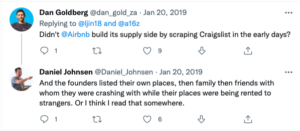Li Jin
Fake Your Way to Marketplace Success
Originally published on Twitter on January 19, 2019
“Fake it til you make it” is a key strategy for overcoming the chicken-and-egg problem of starting a new marketplace, popularized by companies like Uber and Yelp. The idea is to bootstrap one side of the marketplace inorganically in order to attract the other side.
There are a few tactics that fall under this umbrella of faking it in a marketplace, including paying guarantees or subsidizing transactions, managing supply, or producing the supply and demand yourself. Then, at a certain point, the network effect kicks in and organic growth takes over.
A few examples
As an example, Uber launched by going to black-car companies and paying drivers to be available on Uber during certain hours, ensuring that riders would be able to find a ride.
A relationship-coaching marketplace called Relationship Hero scaled to dozens of customers with just one coach — its cofounder! But the website listed ten fake coaches to give users the sense that it was a more active platform with diverse coaches who fit their particular situations. Today, all the coaches listed on Relationship Hero are real.
Reddit notably used a similar strategy, populating its site with fake users and fake content until it had the right tone and enough activity to sustain itself. “By populating the site with accounts whose strings they pulled, the Reddit crew could shape the discourse and sharing of the site in the direction they wanted, and as the real user base grew, these standards held, allowing the fake accounts to fade away.”
 @dan_gold_za and @Daniel_Johnsen on Twitter
@dan_gold_za and @Daniel_Johnsen on Twitter
Beepi, which was a used-car marketplace, had a massive chicken-and-egg problem in attracting sellers and buyers in its initial stages. To solve this, the founders went out and purchased used cars to seed the supply side. After a few months, they moved to the marketplace model.
Managed marketplaces, like the Bird platform, are also a form of “faking it til you make it” where the supply side is employed or otherwise managed by the company. This model is frequently applied to complex services to create a radical improvement in the user experience. Sometimes these managed marketplaces preserve the managed aspect while scaling, while others open up more broadly.
Of course, this “fake it” mentality can be wielded incorrectly or immorally, as in the case of Theranos, which achieved a $9 billion valuation based on a product that didn’t work. There is a fine line between creating artificial value in the short term in order to provide more value to your consumer in the long term, and “faking” a product that doesn’t exist.
Other marketplace strategies
That being said, “fake it til you make it” will live on as a strategy, and it can be applied not just to building marketplaces but to all sorts of new networks, like dating, socializing, etc. Creating new marketplaces from scratch and overcoming the cold start is challenging, and creative strategies are often needed.
For example, Chris Dixon writes about a “come for the tools, stay for the network” approach, like how Instagram initially attracted users to its marketplace via its innovative photo filters.
What strategies for building marketplaces have you seen succeed? Get in touch, I’d love to hear from you.
